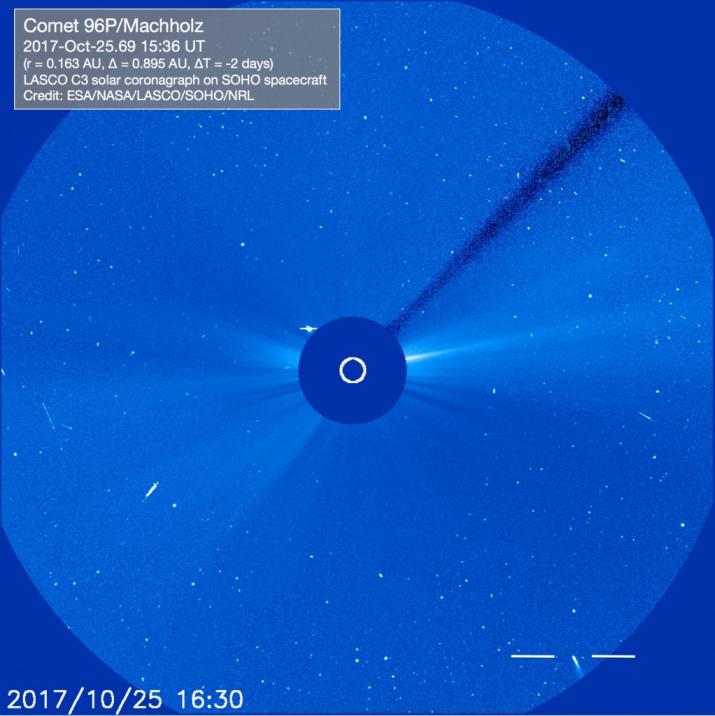NEW DISCOVERIES, THE FIRST INTERSTELLAR ASTEROID AND 96P/MACHHOLZ IN SOHO
2017-October-25
Lots of exciting news has broken within the comet community the past few days.
In no particular order…
C/2017 T1 (Heinze) was discovered by Ari Heinze with the ATLAS (Asteroid Terrestrial-impact Last Alert System) survey on October 2nd at 18th magnitude. Perihelion will be on February 21 of next year at 0.58 au. The comet appears to be intrinsically faint but due to its small perihelion distance and a pre-perihelion close approach to Earth in early January at 0.22 au, it is possible that this comet will become bright enough for small telescope observers. Its 97° inclination orbit will make it well placed for northern hemisphere observers pre-perihelion. After perihelion it will only be visible from the southern hemisphere. We don’t know if it is dynamically old or new yet. If it is dynamically new, its intrinsic faintness suggests it could be a candidate for disintegration as it nears perihelion.
C/2017 T2 (PANSTARRS) was first observed by PANSTARRS on September 15 at 20th magnitude. It is currently 9 au from the Sun but will get much closer with a perihelion on 2020 May 5 at 1.62 au. It won’t be too close to Earth when at perihelion (~1.6 au) but could be 8th magnitude and well placed for northern observers during much of 2020. Usually when small perihelion comets are discovered so far out it is because they are dynamically new and hyperactive when far out and inbound. C/2017 T2 appears to be dynamically old so it will be interesting to see how its brightness evolves as it gets closer.
A/2017 U1 is odd. First off, it has an A/ prefix meaning it was originally classified as a comet and then reclassified as an asteroid. Secondly, it has an eccentricity of 1.19! It is very possible that this object was never gravitationally bound to the Sun and is the first definitive interstellar asteroid. With a ‘radiant’ near the solar apex, the orbit is even aligned in the direction expected for most interstellar objects to radiate from (in effect, the direction the solar system car is driving in). With a perihelion of 0.25 au on September 9, the object was first designated as C/2017 U1 (PANSTARRS) since its orbit is very comet-like (even though it is extremely hyperbolic). Deep imaging by Karen Meech (U. of Hawaii) with the Very Large Telescope revealed no apparent cometary activity. While an asteroidal origin at first seems odd, there are estimates that 99+% of our solar system’s asteroids were ejected so it is very possible that there are just as many wandering asteroids as comets in interstellar space. Unfortunately, this object is already 21st-22nd magnitude and rapidly fading. Hopefully the very large telescopes will be able to get some colors and spectra.
Link to Sky and Telescope article on A/2017 U1.
96P/Machholz is now 2 days from its own very close perihelion (0.12 au) and in the field of view of the LASCO C3 coronagraph on the SOHO spacecraft. You can go to the SOHO image site to see the comet entering the FOV at around 5 o’clock. Above, I mentioned that A/2017 U1 was our first definitive interstellar asteroid. Due to 96P’s odd chemical make-up (at least compared to most comets) has led some to suggest that 96P is itself a captured interstellar comet. So while we can’t go out and observe 22nd magnitude A/2017 U1 we can watch soon to be 2nd magnitude 96P from the comfort of our home computer.
96P is visible between the white lines in the lower right of the below SOHO Lasco C3 image.
- Carl Hergenrother (ALPO Comet Section Coordinator)




